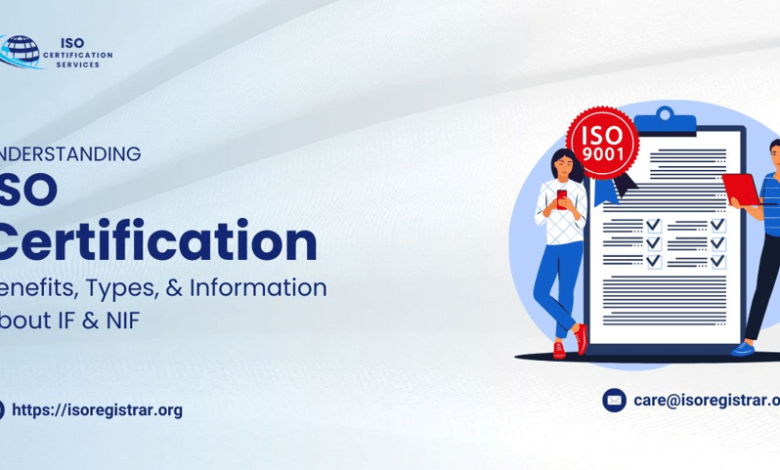Understanding ISO Certification: Benefits, Types, and Information About IF and NIF

ISO, or the International Organization for Standardization, is a globally recognized entity that develops and publishes international standards. These standards ensure the quality, safety, efficiency, and interoperability of products and services across various industries. The term “ISO” is derived from the Greek word “isos,” meaning equal, symbolizing the organization’s role in establishing uniform standards.
What is ISO?
ISO Certificate is an independent, non-governmental international organization founded in 1947. It comprises national standards bodies from 167 countries, with one member per country. ISO develops and publishes standards through a consensus process involving experts from various fields, ensuring that the standards are relevant and widely applicable.
Purpose of ISO
The primary goal of ISO is to facilitate international trade by creating standards that are recognized and adopted worldwide. These standards cover a wide range of sectors, including technology, food safety, agriculture, healthcare, and more. ISO standards ensure that products and services are safe, reliable, and of high quality.
Benefits of ISO
1. Improved Quality and Consistency
ISO standards provide a framework for companies to ensure their products and services meet consistent quality levels. This helps build trust with customers, as they can be confident that ISO-certified products and services meet rigorous quality criteria.
2. Enhanced Efficiency
Adopting ISO standards can streamline business processes, reducing waste and improving efficiency. This can lead to cost savings and more effective use of resources, benefiting both the company and its customers.
3. Increased Market Access
ISO certification is often a requirement for entering certain markets or working with specific clients. Being ISO-certified can open up new business opportunities and increase competitiveness in the global market.
4. Risk Management
ISO standards include guidelines for identifying, assessing, and managing risks. By adhering to these standards, organizations can reduce the likelihood of failures and enhance their ability to respond effectively to potential issues.
5. Regulatory Compliance
Many ISO standards are aligned with regulatory requirements. Implementing these standards can help organizations comply with local and international regulations, avoiding legal issues and potential fines.
6. Customer Satisfaction
By ensuring that products and services meet high standards of quality and safety, ISO certification can lead to higher customer satisfaction and loyalty. Customers are more likely to trust and return to businesses that adhere to recognized standards.
Types of ISO Standards
ISO has published over 23,000 standards covering various aspects of technology and business. Some of the most well-known ISO standards include:
1. ISO 9001 (Quality Management Systems)
ISO 9001 sets out the criteria for a quality management system (QMS). It is the only standard in the ISO 9000 series that can be certified to and is based on several quality management principles, including a strong customer focus, the involvement of top management, and a process approach to continuous improvement.
2. ISO 14001 (Environmental Management Systems)
ISO 14001 provides a framework for organizations to improve their environmental performance through more efficient use of resources and reduction of waste. It helps businesses systematically manage their environmental responsibilities.
3. ISO 27001 (Information Security Management Systems)
ISO 27001 specifies the requirements for establishing, implementing, maintaining, and continually improving an information security management system (ISMS). It includes a set of best practices for managing information security risks.
4. ISO 45001 (Occupational Health and Safety Management Systems)
ISO 45001 provides a framework for managing occupational health and safety (OH&S) risks. It helps organizations create safer working environments by reducing workplace hazards and preventing work-related injuries and illnesses.
5. ISO 22000 (Food Safety Management Systems)
ISO 22000 sets out the requirements for a food safety management system. It ensures that food products are safe for consumption and helps organizations in the food industry manage food safety hazards effectively.
Read also: Types and Categories of Digital Signatures
About IF and NIF
Intermediate Frequency (IF)
Intermediate Frequency (IF) refers to a stage in signal processing where an original radio frequency (RF) signal is converted to a lower frequency before further processing. This technique is commonly used in superheterodyne radio receivers, radar systems, and satellite communication. The benefits of using IF include:
Improved Signal Processing: Lower frequencies are easier to filter and amplify with greater accuracy.
Enhanced Sensitivity and Selectivity: IF allows for better tuning and discrimination between closely spaced signals.
Simplified Circuit Design: Using a common IF simplifies the design of multiple stages of the receiver.
National Infrastructure Framework (NIF)
The National Infrastructure Framework (NIF) is a comprehensive approach to planning, developing, and maintaining a country’s infrastructure. This includes transportation networks, energy systems, water supply, and telecommunications. The NIF aims to ensure that infrastructure development is sustainable, resilient, and capable of meeting future demands. Key components of NIF include:
Strategic Planning: Identifying long-term infrastructure needs and prioritizing projects based on economic, social, and environmental considerations.
Investment and Funding: Securing financial resources for infrastructure projects through public and private investment.
Regulatory Framework: Establishing policies and regulations that support efficient and transparent infrastructure development.
Maintenance and Upgrades: Ensuring existing infrastructure is well-maintained and upgraded as needed to meet evolving demands and standards.
Note: Apply for ISO 22000:2018NON-IAF through the official portal.
Conclusion
ISO standards play a crucial role in ensuring the quality, safety, and efficiency of products and services worldwide. They offer numerous benefits, including improved quality and consistency, enhanced efficiency, increased market access, better risk management, regulatory compliance, and higher customer satisfaction. Understanding the various types of ISO standards, such as ISO 9001 for quality management and ISO 14001 for environmental management, helps organizations choose the right standards to implement. Additionally, specialized concepts like Intermediate Frequency (IF) and the National Infrastructure Framework (NIF) demonstrate the diverse applications of standardization in both technical and infrastructural contexts. Embracing ISO standards and frameworks can lead to significant improvements in business operations and infrastructure development, fostering a more reliable and sustainable global economy.






